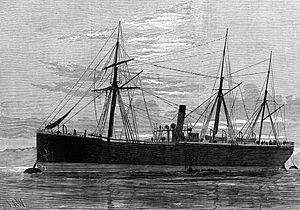SS Bywell Castle (1869) facts for kids

Bywell Castle, 1878
|
|
Quick facts for kids History |
|
|---|---|
| Name | Bywell Castle |
| Namesake | Bywell Castle |
| Owner | Hall Brothers |
| Port of registry | |
| Builder | Palmers Shipbuilding and Iron Company |
| Yard number | 250 |
| Launched | 20 November 1869 |
| Completed | January 1870 |
| Maiden voyage | 9 February 1870 |
| Out of service | February 1883 |
| Identification | |
| Fate | Foundered or wrecked |
| General characteristics | |
| Class and type | Cargo liner |
| Tonnage | 1,376 GRT, 892 NRT |
| Length | 254 feet 3 inches (77.50 m) |
| Beam | 32 feet 1 inch (9.78 m) |
| Depth | 19 feet 6 inches (5.94 m) |
| Installed power | Compound steam engine, 120hp |
| Propulsion | Single screw propeller, sails |
| Sail plan | Barquentine |
| Crew | 22 |
Bywell Castle was a large ship built in 1869. She was designed to carry both passengers and cargo. This ship was involved in a very serious accident in September 1878. She collided with another ship, the Princess Alice, leading to the loss of over 600 lives. Bywell Castle herself disappeared in February 1883 while sailing from Egypt to England.
About the Ship
Bywell Castle was a big ship, measuring about 254 feet 3 inches (77.50 m) long. That's longer than two basketball courts! She was also 32 feet 1 inch (9.78 m) wide and 19 feet 6 inches (5.94 m) deep.
The ship was powered by a special type of steam engine. This engine had a power of 120 horsepower. It turned a single propeller to move the ship through the water. Bywell Castle also had sails, like older ships, to help her move. She had a crew of 22 people.
Ship's Journey and Life
Bywell Castle was built by Palmers Shipbuilding and Iron Company in Jarrow, England. She was launched into the water on November 20, 1869. The ship was finished and ready to sail in January 1870. Her home port was London, and she was given special identification numbers and code letters.
Her first long trip began on February 9, 1870. She sailed from London all the way to Bombay and Kurrachee in India. During this trip, she faced strong storms in the English Channel and the Bay of Biscay. Even though the journey was good, people noted that the ship was better suited for carrying goods than passengers.
Over the years, Bywell Castle had several adventures and challenges:
- In January 1873, she had to stop in Plymouth, England. She had lost her steering gear and two lifeboats during a voyage.
- In February 1873, she became a hero! She rescued 17 sailors from a British ship called Satellite that was sinking in the Atlantic Ocean.
- Just a few days later, she rescued the crews of two more ships, the Young Marquis and the Anne Foster. These sailors were taken to Gibraltar.
- In November 1873, she was stopped from sailing because she was carrying too much cargo.
- In July 1876, she helped another ship, the Dorothy, which had been badly damaged in a collision. Bywell Castle towed the damaged ship to safety.
- In 1877, her boiler, which helps power the steam engine, was replaced.
The Princess Alice Disaster
On September 3, 1878, Bywell Castle was involved in a terrible accident. She collided with a paddle steamer named Princess Alice on the River Thames in England. The Princess Alice quickly sank, and more than 600 people lost their lives.
At first, both ships were blamed for the collision. However, after an appeal, Bywell Castle was later found not to be at fault for the accident.
Final Voyage
In May 1881, Bywell Castle found another ship, the California, in trouble in the Atlantic Ocean. The California's engines had broken down. Bywell Castle towed the disabled ship for a long distance, about 876 nautical miles (1,622 km), to Halifax, Canada. For this brave rescue, Bywell Castle was awarded £3,000.
In February 1883, Bywell Castle was reported missing. She was on a trip from Alexandria, Egypt, to Hull, England, carrying beans and cotton seeds. She was last seen on January 29 off the coast of Portugal. It was thought she might have sunk in a storm in the Bay of Biscay. Later that month, a ship matching her description was wrecked off the coast of Norfolk, England, with no survivors. An investigation into her loss concluded that she was carrying too much cargo, which likely contributed to her disappearance.

